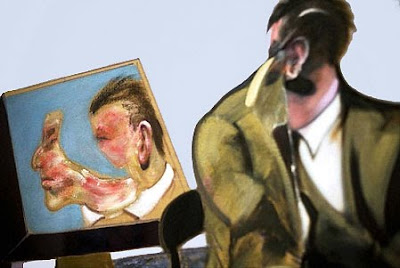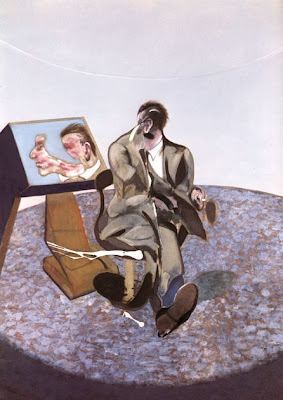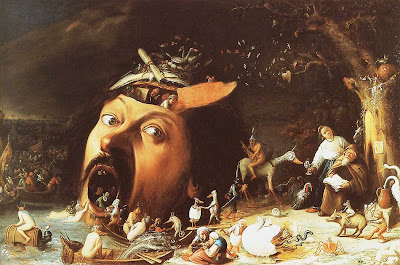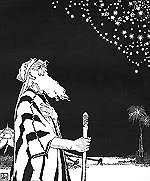FICTITIOUS Syn imaginary, fantastic, chimerical, fictional, made-up, fabricated, suppositious, untrue. Ant real, factual, confirmed, proven, true.
Can a fantastic figure convey a truth of its own? According to Italian philosopher Giordano Bruno (1548-1600), the fictitious image entails its own truth.[1]
An imaginary painting is a fictional picture, which depicts a fictitious world or exists in a fictitious world.
In the Grotteschi, a series of four engravings of 1747-50, Giovanni Battista Piranesi assembles true archaeological fragments from Classical Rome in fully invented compositions. Each of them is a capriccio or architectural fantasy.
Both fantastic art and grotesque art comprise pictures showing imaginary beings. Such fictitious figures may suggest real possibilities.
FICTICIO. 1 fantástico, fabuloso, quimérico, imaginario, imaginado; 2 irreal, inventado, supuesto, aparente, fingido, simulado, engañoso, falso. Ant real, auténtico, verdadero, verídico.
Giordano Bruno, De vinculis in genere (A General Account of Bonding), 1588-91, pt. 2, art. XXX (Os vínculos, trad. Elaine Santorelli, Sao Paulo: Hedra, 2012, p. 55: "a aparência fantástica tem sua verdade"); Roger Caillois, Au coeur du fantastique, Paris: Gallimard, 1965: "L'image fictive possède sa propre vérité").
Original text, in Latin: Giordano Bruno, De vinculis in genere, 1588-91: De vincibilibus in genere, Art. XXX, Vincibilis veritas: "Etsi enim nullus sit infernus, opinio et imaginatio inferni sine veritatis fondamento vere et verum facit infernum; habet enim sua species phantastica veritatem" (Jordani Bruni Nolani opera latine conscriptapta publicis sumptibus edita, Napoli: D. Morano, 1879-91, vol. 3, fol. 93v; HTML edition by Joseph H. Peterson, 1997; La biblioteca ideale di Giordano Bruno, Italy, 2000).
An Italian version: "anche che non esista inferno, la credenza immaginaria nell'inferno senza fondamento di verità produce veramente un vero inferno: l'immagine fantastica ha la sua verità" (De vinculis in genere, 1589–91, trad. it. F. Tocco, E. Vitelli, Pordenone: Edizioni Biblioteca dell'Immagine, 1987, XXX, La verità vincolabile, p. 175).
Michelangelo in Da pintura antiga (1548) remarks on painting imaginary beings: "But if it so happens [...] a work [...] under pain of otherwise becoming shameful or false, requires fantasy [... and that] certain limbs or elements of a figure are altered by borrowing from other species, for example transforming into a dolphin the hinder end of a griffon or a stag [...] these alterations will be excellent and the substitution, however unreal it may seem, deserves to be declared a fine invention in the genre of the monstrous. When a painter introduces into this kind of work of art chimerae and other imaginary beings in order to divert and entertain the senses and also to captivate the eyes of mortals who long to see unclassified and impossible things, he shows himself more respectful of reason than if he produced the usual figures of men or of animals" (Marina Warner, Monsters of Our Own Making: The Peculiar Pleasures of Fear, Lexington: University Press of Kentucky, 2007, pp. 249-50).
On Warner's book, from the publisher: "Since the beginning of storytelling, monsters of all kinds have inhabited myths, legends, folklore, and oral traditions, and they continue to thrive amidst society's ever-increasing attraction to the thrill of experiencing fear. Today many of us seek out horror movies, read thrillers and Gothic novels, and visit haunted houses, in our endless pursuit of the macabre and exciting. In Monsters of Our Own Making: The Peculiar Pleasures of Fear, Marina Warner explores the world of bogeys from their incarnation as ogres in nursery tales to their current role in the new, twisted reality of contemporary conflicts, where there is no guarantee of a happy ending. Marina Warner digs into the past to uncover the origins of these myths, to examine their history and social function over time. Paying particular attention to the prevalence of male figures of terror, Warner reveals their connections to current ideas about sexuality and power, identity and ethnicity, youth and age."
Notes and References
1. The Art and Popular Culture Encyclopedia, 17.11.2012.
 |
| Francis Bacon: George Dyer |
Can a fantastic figure convey a truth of its own? According to Italian philosopher Giordano Bruno (1548-1600), the fictitious image entails its own truth.[1]
 |
| Francis Bacon Portrait of George Dyer in a Mirror 1968 Museo Thyssen-Bornemisza, Madrid |
An imaginary painting is a fictional picture, which depicts a fictitious world or exists in a fictitious world.
In the Grotteschi, a series of four engravings of 1747-50, Giovanni Battista Piranesi assembles true archaeological fragments from Classical Rome in fully invented compositions. Each of them is a capriccio or architectural fantasy.
 |
| The Grotteschi: Capriccio II - The Triumphal Arch |
Both fantastic art and grotesque art comprise pictures showing imaginary beings. Such fictitious figures may suggest real possibilities.
La imagen fantástica posee su propia verdad.
FICTICIO. 1 fantástico, fabuloso, quimérico, imaginario, imaginado; 2 irreal, inventado, supuesto, aparente, fingido, simulado, engañoso, falso. Ant real, auténtico, verdadero, verídico.
Giordano Bruno, De vinculis in genere (A General Account of Bonding), 1588-91, pt. 2, art. XXX (Os vínculos, trad. Elaine Santorelli, Sao Paulo: Hedra, 2012, p. 55: "a aparência fantástica tem sua verdade"); Roger Caillois, Au coeur du fantastique, Paris: Gallimard, 1965: "L'image fictive possède sa propre vérité").
Original text, in Latin: Giordano Bruno, De vinculis in genere, 1588-91: De vincibilibus in genere, Art. XXX, Vincibilis veritas: "Etsi enim nullus sit infernus, opinio et imaginatio inferni sine veritatis fondamento vere et verum facit infernum; habet enim sua species phantastica veritatem" (Jordani Bruni Nolani opera latine conscriptapta publicis sumptibus edita, Napoli: D. Morano, 1879-91, vol. 3, fol. 93v; HTML edition by Joseph H. Peterson, 1997; La biblioteca ideale di Giordano Bruno, Italy, 2000).
An Italian version: "anche che non esista inferno, la credenza immaginaria nell'inferno senza fondamento di verità produce veramente un vero inferno: l'immagine fantastica ha la sua verità" (De vinculis in genere, 1589–91, trad. it. F. Tocco, E. Vitelli, Pordenone: Edizioni Biblioteca dell'Immagine, 1987, XXX, La verità vincolabile, p. 175).
Michelangelo in Da pintura antiga (1548) remarks on painting imaginary beings: "But if it so happens [...] a work [...] under pain of otherwise becoming shameful or false, requires fantasy [... and that] certain limbs or elements of a figure are altered by borrowing from other species, for example transforming into a dolphin the hinder end of a griffon or a stag [...] these alterations will be excellent and the substitution, however unreal it may seem, deserves to be declared a fine invention in the genre of the monstrous. When a painter introduces into this kind of work of art chimerae and other imaginary beings in order to divert and entertain the senses and also to captivate the eyes of mortals who long to see unclassified and impossible things, he shows himself more respectful of reason than if he produced the usual figures of men or of animals" (Marina Warner, Monsters of Our Own Making: The Peculiar Pleasures of Fear, Lexington: University Press of Kentucky, 2007, pp. 249-50).
On Warner's book, from the publisher: "Since the beginning of storytelling, monsters of all kinds have inhabited myths, legends, folklore, and oral traditions, and they continue to thrive amidst society's ever-increasing attraction to the thrill of experiencing fear. Today many of us seek out horror movies, read thrillers and Gothic novels, and visit haunted houses, in our endless pursuit of the macabre and exciting. In Monsters of Our Own Making: The Peculiar Pleasures of Fear, Marina Warner explores the world of bogeys from their incarnation as ogres in nursery tales to their current role in the new, twisted reality of contemporary conflicts, where there is no guarantee of a happy ending. Marina Warner digs into the past to uncover the origins of these myths, to examine their history and social function over time. Paying particular attention to the prevalence of male figures of terror, Warner reveals their connections to current ideas about sexuality and power, identity and ethnicity, youth and age."
Notes and References
1. The Art and Popular Culture Encyclopedia, 17.11.2012.












